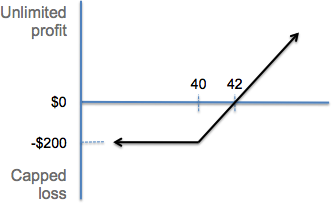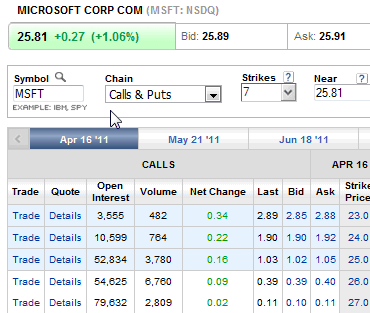What is a Call Option?
How do You Make Money Trading Calls?
Related Terms:
- How To Buy A Call
- How to Turn $4,000 into $20,000 with Options Trading
- Cheapest Option Brokers
- Put Option Definition
- Top 10 Option Trading Tips
Call Option Definition:
A Call Option is security that gives the owner the right to buy 100 shares of a stock or an index at a certain price by a certain date. That "certain price" is called the strike price, and that "certain date" is called the expiration date. A call option is defined by the following 4 characteristics:
- There is an underlying stock or index
- There is an expiration date of the option
- There is a strike price of the option
- The option is the right to BUY the underlying stock or index. This contrasts to a put option, which is the right to sell the underlying stock
Long Call Example

A call option is called a "call" because the owner has the right to "call the stock away" from the seller. It is also called an "option" because the owner has the "right", but not the "obligation", to buy the stock at the strike price. In other words, the owner of the option (also known as "long a call") does not have to exercise the option and buy the stock--if buying the stock at the strike price is unprofitable, the owner of the call can just let the option expire worthless.
The most attractive characteristic of owning call options is that your profit is technically unlimited. And your loss is limited to the amount that you paid for the option. Look at this call options payoff diagram and you will see what I mean. This diagram shows the payoff for owning call options with a strike price of $40 and a cost of $2. You will notice that if the stock price closes at or below $40, you lose the $200 ($2 price times 100 shares) cost of buying the option (note the horizontal line intersecting the y-axis at -$200). You will also notice that as the stock price increases above $40 the line slopes up indicating your profit. Finally, notice that the up sloping line become profitable at $42, which is the strike price of $40 plus the $2 cost of buying the option. Theoretically the stock price can go to infinity so that is why they say the earnings from owning a call option are unlimited.
Since owning options is always cheaper than owning the stock itself, when you KNOW a stock price is about to move up it is ALWAYS more profitable to own calls on the stock than it is to own the stock itself! Keep reading and I will explain why.
Take a look at the screen shot to the right that is from my Etrade account. This shows that Microsoft (MSFT) is at $25.81 and that the April options expire on April 16, 2011 and that the strike prices for the call and put range from at least $23 to $28 and are at every dollar in between.
Since call options give the owner the right to buy a stock at a fixed price, owning calls allows you to lock in a maximum purchase price for a stock. It is a maximum purchase price because if the market price is lower than your strike price, then you would buy the stock at the lower market price and not at the higher exercise price of your option. It is called "a call option" because it allows you to "call" the stock away from somebody (ie, buy it).
Call Option Example

Calls trade on an exchange (The Chicago Board of Options Exchange--CBOE), just like stocks do. Like all securities, all calls and puts have a unique ticker symbol and their prices are determined by the market's buyers and sellers. The collection of buyer and sellers, and their expectation of the movement of the underlying stock, determine the current prices.
Options have a bid and ask price just like stocks do, but because the volume on options is much lower than the volume on stocks, the spread between the bid price and the ask price is much higher than the bid/ask spread on stocks. Whereas the bid/ask spread on stocks is usually just one or two cents, the bid/ask spread on call options and put options can be as high as 20 cents or more.
Look at the screen print of the MSFT options above. You will see that the bid/ask spread ranges from 3 cents on the 23 strike price (bid $2.85 / ask $2.88) to 1 cent on the 26 strike price (bid $0.39 / ask $0.40).
When to Buy Call Options Examples:
If you think a stock price is going to go up, then there are 3 trades that you can make to profit from a rising stock price:
- you can buy the stock
- you can buy call options on the stock, or
- you can write put options on the stock
Calls and Puts Trading Tip: Before we get too far along in talking about call options and trading call options, you need to understand that a stock price can move in three directions, not just two:
- A stock price can go up
- A stock price can go down, and
- It can stay the same!
Keep these 3 directions in mind as you read on. The rest of this page is devoted to understanding what call options are.
Call Options Example:
Suppose YHOO is at $40 and you think YHOO's stock price is going to go up to $50 in the next few weeks. One way to profit from this expectation is to buy 100 shares of YHOO today at $40 and sell it in a few weeks when it goes to $50. This would cost $4,000 today and when you sold the 100 shares of YHOO stock in a few weeks you would receive $5,000 for a $1,000 profit and a 25% return.
That sounds great, but watch how buying a call option on YHOO would have given you a 400% return (instead of the 25% return from buying the stock!
Continue reading for more examples...

Here are the top 10 option concepts you should understand before making your first real trade: